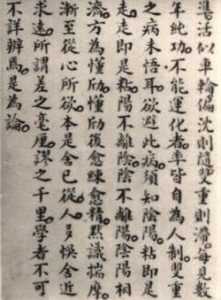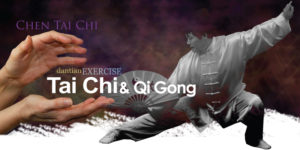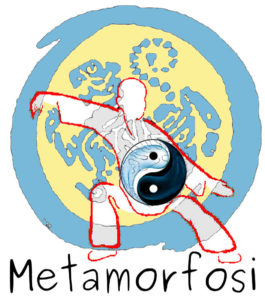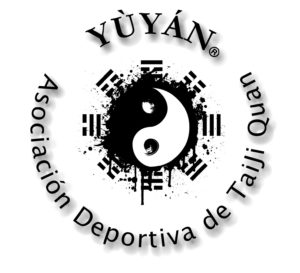Slanted FlyingJournal of Tai Chi Chuan
Philosophy
Hitting Taijiquan’s Sweet Spot
A person is a mixture of yin and yang and cannot be absolutely one or the other (in the Taijitu there is a dot of the opposite within each half), so “soft” could be viewed as being “relative” to the “hard” of the opponent. The opponent is yang + yang (hard) while the yin (soft) in my yin + yang counters one side of his yang + yang. My yin not only counters one side of his yang, it also weakens his other yang side by drawing it into my yin side (leading into softness), and this allows an opening or vulnerability for an attack using the yang side of my yin + yang.
The softness of water is sometimes used as an analogy in Taijiquan, and the ability of water to float a boat can be seen as analogous to the yin + yang balance that we are trying to emulate (yin being water yielding and allowing the boat to sink below the surface of the water, while yang would be the buoyancy created by the water that lifts the boat). If the water is sufficiently deep, it can float a toy boat as well as it can an aircraft carrier, though their weight is significantly different. The sweet spot of the “s-curve” line separating the yin from the yang in the Taijitu accommodates, within the practitioner’s physical limits, any weight and any degree of pressure from an opponent.
Once you have engrained these techniques, you will gradually come to identify energies…
We want to be able to instantly identify when the opponent’s energy is pulling or pushing, up or down, left or right, etc, and we can do this if we operate on the line separating yin from yang. We therefore maintain the potential to move in any direction, expressing yin + yang, but emphasizing whichever is appropriate to the immediate situation, while maintaining the ability to instantly switch which energy is emphasized, as will be described later. Yin + yang is being neutral, but not passive, at the point of contact with an opponent.
With your head-top pressing up naturally and energy sinking down to your elixir field, there will be no leaning in any direction…
This section begins to identify yin and yang energies in the practitioner’s body rather than contrasting the practitioner with the opponent.
The up/down energy defines the vertical axis that provides the stability for the body when rotating horizontally. This creates something like a cylinder for the torso which then can rotate right or left in response to the opponent’s energy, and left/right are the primary energies of the body due to our use of the hips to rotate the torso.
…If he tries to find me above, he has to keep reaching higher, or if he tries to find me below, he has to keep reaching lower. When he advances, he cannot get to me, but once he retreats, he cannot get away from me. A feather cannot be added and a fly cannot land…
In addition to left/right, we also want the energies of up/down and forward/backward, and these directions are mentioned here. We want the energies of up and down to extend high into the sky and deep into the earth, even though our physical bodies do not. Like a ball rotating up or down in response to incoming energy, the up or down rotation can continue higher and higher or lower and lower.
We also want to have advance/retreat energies. These should be like a river carrying a boat downstream. The water both pulls (yin) and pushes (yang) the boat; and in a similar way the opponent stays with us, and us with them, regardless of whether they try to advance or to retreat.
This section ends with statements that reflect the six-direction potential of the Taijiquan practitioner, and the ability to instantly sense, and respond to, changes in the energy that the opponent applies.
 … the strong bullying the weak and the slow yielding to the fast...
… the strong bullying the weak and the slow yielding to the fast...
This section contrasts Taijiquan with other styles of martial arts. Other styles may try to be stronger (i.e., more yang) or faster (also more yang) than their opponents, but Taijiquan takes a different training approach. How this is done is described in the next several sections.
Standing like a scale, move like a wheel. If you drop one side, you can move, but if you have equal pressure on both sides, you will be stuck. We often see one who has practiced hard for many years yet is unable to perform any neutralization and is generally under the opponent’s control, and the issue here is that this error of double pressure has not yet been understood.
If you want to avoid this error, you must understand passive and active. In sticking there is yielding and in yielding there is sticking. The active does not depart from the passive and the passive does not depart from the active, for the passive and active exchange roles…
In these sections, the importance of being yin on one side (“drop one side”), and yang on the other (i.e., yin + yang), is emphasized, and having “double pressure” (i.e., yang + yang) is to be avoided. If we maintain yin + yang at the point(s) of contact with an opponent, then we can pivot like a scale or a wheel. If we are yang + yang or yin + yin, then the stronger (or faster) person will win. By maintaining yin + yang at the point of contact, then the energies do not “depart” from each other, and they can instantly “exchange roles” by simply pivoting in another direction.
The basic of basics is to forget about your plans and simply respond to the opponent. We often make the mistake of ignoring what is right in front of us in favor of something that has nothing to do with our immediate circumstances…
This last section brings up the practitioner’s ability to be mentally neutral, neither yin nor yang, and thus being on the thin line of the “s-curve” dividing yin from yang. Practitioners do not want to anticipate what an opponent will do, because one could be wrong and respond incorrectly. We want to respond to the actual situation, not relying on expectations, anticipations, likes, dislikes, routines, habits, emotions like anger and fear, etc.
When both physically and mentally neutral, practitioners can respond appropriately and naturally, like a ball floating on water will instantly respond to being touched. Rather than separating from the opponent (too yin to stick, i.e., yin + yin) or opposing them (too yang to yield, i.e., yang + yang), practitioners seek to be in Taijiquan’s sweet spot (yin + yang).














Thanks, Dan Pasek. RE:Water– Liu He Ba Fa Chuan has also been called “Water Boxing”. “The common perception of the name Water Boxing is that Liuhebafa moves smoothly as if one were floating in water. This is a misconception however and quite misleading from the true meaning. The actual concept of Water Boxing refers to the 3 States of Water; solid/ice, liquid/water and gas/steam. This can hold many meanings but essentially refers to not only ones level of progression and ability in the style but to their application of it as well. Moving against oncoming force and overpowering the opponent is an application of the solid state, moving with oncoming force (different from yielding) is an application of the liquid state, and avoiding the exchange of force all together is an application of the gas state. This water concept is a very important practice of Liuhebafa and its knowledge and application show true depth in the internal arts. In short, Water Boxing is a stage or element of Liuhebafa, not an alternative name nor a separate art.”
http://www.liuhebafachuan.com/liuhebafa.html
NOW… an expanded Water Paradigm is emerging: https://www.youtube.com/watch?v=i-T7tCMUDXU FourthPhase of Water: Dr. Gerald Pollack at TEDxGuelphU RE: GRAVITY…and the alternative paradigm of the Electric Universe: https://www.youtube.com/watch?v=FyZK0xisr4M Electric Stars, Electric Universe | Space News “Published on Jun 28, 2016
The fundamental difference between the Electric Universe and standard cosmology can probably be summarized as follows: The electric universe is a connected universe, where nothing is born or exists in isolation. Filamentary networks of electric currents pervade space, producing the magnetic fields that are now detected at virtually all scales throughout the Universe. Yet even as the existence of electric currents in space has slowly entered the astronomical literature, astronomers still view gravity as the predominant force in the cosmos. Today, Nicholas Sykes discusses the Electric Universe foundations for a new understanding of many phenomena in nature, including our own Sun. ”
SUPPORT US ON PATREON AND WATCH OUR INFLUENCE GROW: “Changing the world through understanding of the Electric Universe.” https://www.patreon.com/tboltsproject